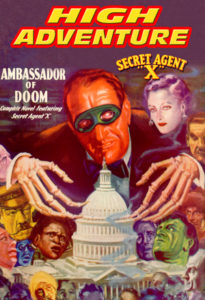Magazine Review: High Adventure #73: Secret Agent “X” Edited by John P. Gunnison
Let’s take another look at this pulp reprint magazine, this time reprinting stories from Secret Agent “X” May 1934.
“Ambassador of Doom” by Brent House: A secret meeting takes place in Washington, D.C. The matter at hand–whether to preserve or destroy the prototype and blueprints of a terrifying new weapon, the paralysis ray! Developed by Professor Browning shortly before his untimely death, the Browning Ray causes permanent and total body paralysis at a great distance. There is no known defense.
Most of those present feel this inhuman terror weapon should be destroyed, but Senator Rathborne disagrees. He believes that the next great war will be won by the country with the most effective weapons, not the one with the most humane treatment of enemy soldiers and civilians. If the Browning Ray will win wars, America should have it. He’s outvoted.
This not being the kind of story where that’s an acceptable ending, the Army officer carrying the blueprints to be destroyed is murdered and the plans stolen. Have foreign agents somehow learned about the Browning Ray, or has Senator Rathborne’s patriotism driven him to the unthinkable? Only one man can get to the bottom of this–Secret Agent “X”!
“Sting of the Scorpion” by Richard B. Sale: Private detective Marty Trent was just about to get bored when he’s called in on a case of extortion. Banker Arthur Barbour is being threatened with death by someone calling themselves “the Scorpion” if he does not make a ludicrously large payment. It might be a bluff–or it might be the precursor of several men bleeding to death…without a wound on their bodies!
Secret Agent “X” was first published in February 1934, headlining a magazine meant to compete with such luminaries as the Shadow and Doc Savage. While never a huge seller, his magazine did manage to survive until 1939.
While other pulp heroes were also masters of disguise, X was notable for never being out of disguise. He had no civilian identity or personal life, remaining nameless even to the readers. X’s backstory was also minimal. He’d been an American intelligence operative during World War One, presumably under his birth name. At some point X had picked up many useful skills at expert level. (There are frequent footnotes explaining that, for example, X is a master at administering anesthetic and hypnotic drugs.)
X reports directly to K-9, a highly placed government official we also never learn any personal details about. Their work is technically extra-governmental and sponsored by a fund created by unnamed wealthy philanthropists. The stories from the original run of the magazine contain not a whiff of cynicism about this shadowy operation.
The closest thing X has to a friend is reporter Betty Dale, who has managed to fall in love with X without ever seeing his real face or interacting with him outside cases they work together. X also feels affectionate towards Betty, but feels it is too dangerous to pursue the relationship beyond collaboration in investigation.
The villain of “Ambassador of Doom” is a step ahead of X at the beginning, divining which person coming into Washington must be the agent, capturing him, and sending an impersonator to meet with K-9. The impersonation fails as K-9 and X have an elaborate confirmation protocol, but it’s not until X makes it look like he’s dead that he is able to make any headway in the case.
An amusing subplot is that one of the suspects is a German spy that X fought back in the Great War, but it turns out the German is also unaware of who has the plans and is attacking X completely by coincidence without knowing of their shared history. I should note that this is a German spy, and not a Nazi spy–the quick way to spot a modern pulp pastiche is heavy use of Nazis as villains, which wasn’t done in the 1930s.
A trivia bit: X disguises himself as a wealthy South American to attend a party, and speaks to the Brazilian ambassador in “excellent Spanish.” I don’t know if Paul Chadwick (who was the author under the house name of Brant House) forgot that Brazil’s language of choice was Portuguese, or if X is playing the part of a boorish non-Brazilian South American who refuses to acknowledge that.
Content warnings: The first story contains a torture scene, and the aftereffects of another. There’s also period racism, and the villain uses “exotic” Malaysians as minions. The second story has some gore, which if illustrated would put it in the “not for children” category.
The X story does a good job of challenging its ubercompetent protagonist and keeping the action going. Characterization is thin on the ground, but adequate for the style of pulp fiction this is. There’s a fairly good secondary female character, but she’s usually off-stage.
The Scorpion story is also fast-paced, but relies on the detective learning things the audience is not privy to until after the Scorpion is exposed. The effects of the venom used are vastly exaggerated for melodramatic purposes.
This issue is worth picking up if you run across it, but is not a must-have if you are on a budget.

